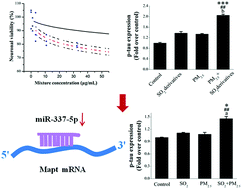Synergistic effects of particulate matter (PM2.5) and sulfur dioxide (SO2) on neurodegeneration via the microRNA-mediated regulation of tau phosphorylation†
Abstract
Because air pollution is a complex mixture of pollutants consisting of both particulate and gaseous components, understanding the health risks from these pollutants requires an evaluation of their combined effects rather than predictions based on the toxicities of single chemicals alone. Particulate matter (PM2.5) and sulfur dioxide (SO2) commonly co-exist in the atmospheric environment, and epidemiological studies have linked air pollution to the development of neurodegenerative disorders, in addition to increased morbidity from cardiopulmonary diseases. However, few studies have examined the potential effects from combinations of these pollutants on neurodegeneration, especially at NOEC doses. In the present study, we first found that PM2.5 and SO2 co-exposure leads to neurodegeneration at low doses, including neuronal apoptosis, the reduction of synaptic structural protein postsynaptic density (PSD-95) and synaptic functional protein N-methyl-D-aspartate (NMDA) receptor subunits (NR2B), and the elevation of tau phosphorylation in vitro and in vivo, which did not induce clear effects when the compounds were tested separately. Furthermore, we clarified that the microRNA (miRNA) miR-337-5p, which is homologous to a human miRNA that targets tau, was involved in the combined effect and contributed to synergistic neurodegeneration. This work implies the potential risk of neuronal dysfunction from the co-existence of PM2.5 and SO2 in coal-burning areas and provides new insights into the molecular markers for the relevant diseases.

- This article is part of the themed collection: Toxicology Research 2017 Most Downloaded Articles

 Please wait while we load your content...
Please wait while we load your content...